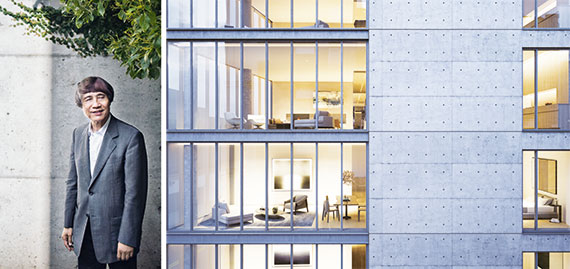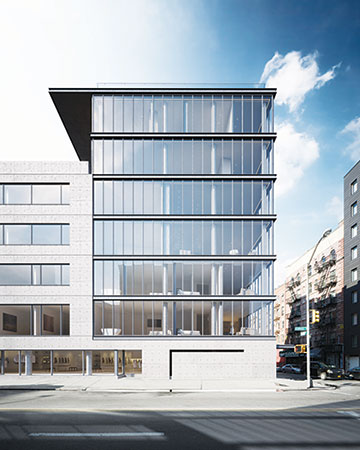Trending
Tadao Ando’s first NYC building bears his signature, but won’t stand out
Japanese master’s design has little to make it seem inspired

It is good news for New York (in specific) and for architecture (in general) that the 73-year-old Tadao Ando agreed to design a new building at 152 Elizabeth Street at the point where it intersects with Kenmare Street.
A Pritzker Prize-winning architect based in Osaka, Japan, he has built all over the world, and has even done some residential interiors in the Big Apple, as well as “Iron Chef” Masaharu Morimoto’s eponymous Japanese restaurant in the Meatpacking District.
But heretofore, developers have not succeeded in procuring his services for an actual stand-alone building in Manhattan.
That will now change, it appears, thanks to the exertions of the developers Sumaida + Khurana, whose art world cred is clearly proved by their having a plus sign in their name, rather than an “and” or, God forbid, an ampersand. Whatever inducement they and their partners, private equity firm Nahla Capital, marshaled to their cause for their first New York City building, however, it seems to have worked, and it is difficult to shake the belief that Ando is doing Gothamites a favor by consenting to design a building here. Most starchitects feel that way, but in his case it may actually be true.
Indeed, the same firm has even secured the services of the equally elusive Portuguese architect Alvaro Siza for his first building in the United States, a proposed 400-foot-tall building in Midtown.
On Elizabeth Street, Ando will create a far smaller structure, seven stories in all, containing a mere seven apartments that will range from about $6 million for a half-floor unit to more than $30 million for the four-bedroom penthouse. The building will be confected out of the poured-in-place concrete used in many of this architect’s buildings, as well as galvanized steel and sheer glass for the floor-to-ceiling windows. It also promises to have a living green wall nearly 100 feet wide and more than 50 feet high, thus making it one of the largest in the city, or anywhere else.
Meanwhile, the press release informs us that the wood for the flooring comes from trees that are over 250 years old, a fact that is impressive and admirable, as long as you don’t think about it too much. If you do, it starts to seem like the arboreal equivalent of a mounted stag’s head, antlers and all, and such satisfaction as one might have from it is apt to consist in the knowledge that nature, in one of its more ancient forms, has now been subdued by human art and acquired by human wealth.
In terms of its design, 152 Elizabeth Street is in a sense two buildings in one. The taller of the two, by two floors, consists of six stories of pristine curtain wall, raised up on a concrete plinth or podium. Interspersed between these floors are exposed I-beams that are reprised in the flat roof, which cantilevers around 10 feet over the smaller building to the east. Here the mural element formed by broad expanses of concrete, is far more pronounced, although the result feels far more conventional.
In truth, the ultimate success of the building, which is expected to be complete in late 2016, will consist in the skill of its manufacture, which, if Ando’s previous works are any indication, will be very high indeed. Few people, with the possible exception of Louis Kahn, have drawn more evocative poetry out of bare concrete than Tadao Ando.
The result promises to be a worthy structure, and one that, through the quality of its workmanship, will doubtless impress the average passerby as well as the more studious scholars of architecture. And yet I must register a certain dissatisfaction with this development. There is nothing at all wrong with Ando’s design — other than the fact that he can do so much better.
Why does it seem as though there were something in the very air over the five boroughs that (with eminent exceptions, of course), draws even the finest international masters round to the nearest available mediocrity? The workmanship, as I say, should be very good on Elizabeth Street, but the design is perhaps a little lackluster.
For all the refinement of the details, the two halves of the building are the sort of thing that many a second-tier architect could have produced — and has produced — around the city. With a few adjustments, and minus a few admitted refinements, is there much in the six floors of curtain walls that we have not seen 1,000 times in the five boroughs? Other than the exposed concrete in the lower half of the building, there is little, if anything, in the design as it meets the eye that is not entirely typical of New York.
In this regard, it appears as though Ando’s 152 Elizabeth Street is yet another instance of a building by a high-minded Japanese master whose style of austere, rectilinear minimalism, which by its very nature flirts with a certain inertia, tips over into tedium on the island of Manhattan. (Fumihiko Maki’s Tower 4 at the World Trade Center and Yoshio Tanaguchi’s revised Museum of Modern Art are, to some degree, further examples.)
At least that is the overwhelming impression you get when you compare what Ando has designed here with what he has done, well, anywhere else.
Surely, there is a constant element to his buildings, their geometric purity and the laying bare of their materials, whether glass or concrete or steel, that will be borne out on Elizabeth Street as well. But that inspiration that raises Ando’s best projects to a higher level of invention, that touch of the poet, is nowhere in evidence in the Elizabeth Street project. Where is that brilliant and inventive contrast that defines his building for the Langen Foundation in Westphalia, Germany, its concrete core wrapped in an exquisite crystal box of perfectly proportioned glass on all sides, as well as the roof? Or that stunning parody of Le Corbusier’s Unite d’Habitation at the Novartis headquarters in Basel, Switzerland, its perfectly proportioned box propped up on pylons and covered on all sides by brise-soleil that have the refinement of watered-silk? Or the library of Japan’s Shiba Ryotaro Memorial Museum in the Osaka Prefecture, whose shelves rise up three stories to contain 20,000 volumes, and in the process create a dizzying cross between architecture and conceptual art? None of that, unfortunately, is likely to materialize in Tadao Ando’s first venture in New York City.
Allow me to repeat, more emphatically than before, that there is nothing wrong with 152 Elizabeth Street, and that, if any other architect had made it, I’d have been happy enough with it. But Tadao Ando can do far better, and to see yet another fine architect have his wings clipped by the Manhattan market is by all accounts a dreary spectacle.





